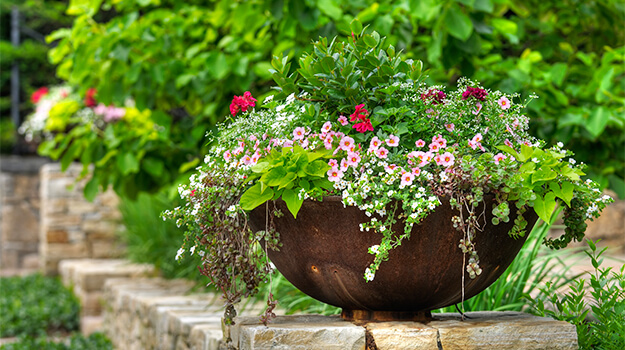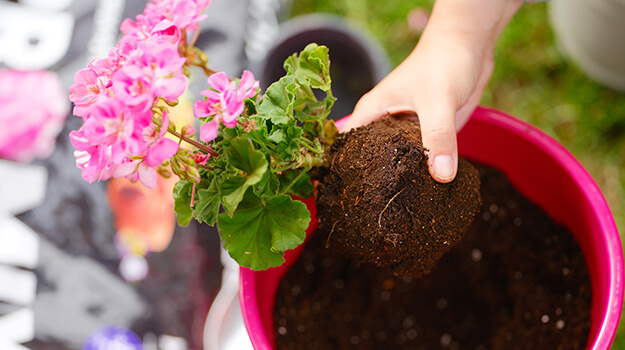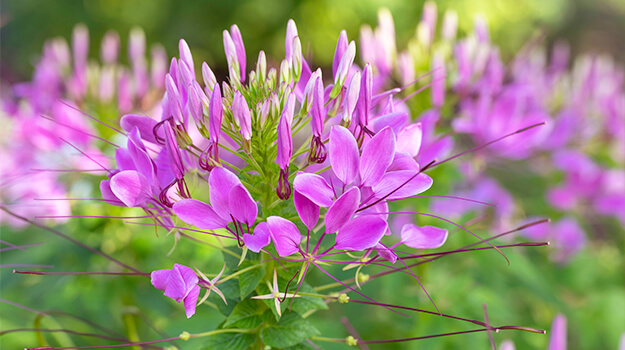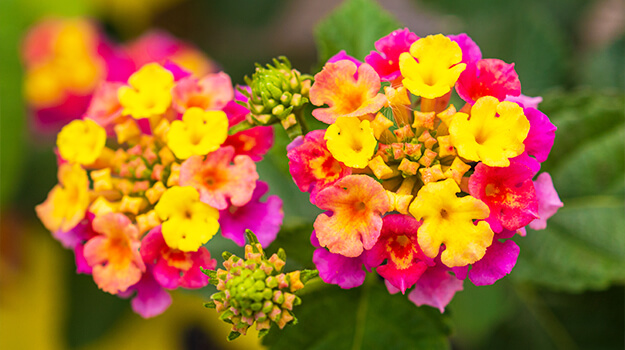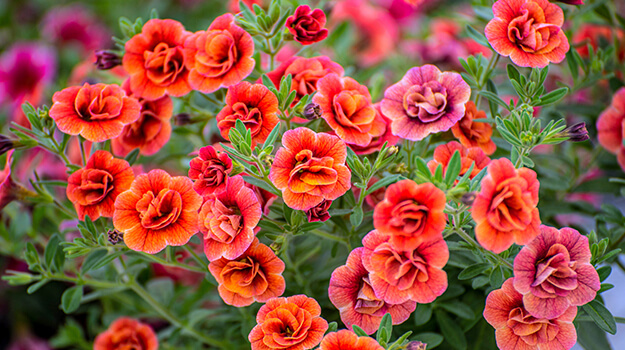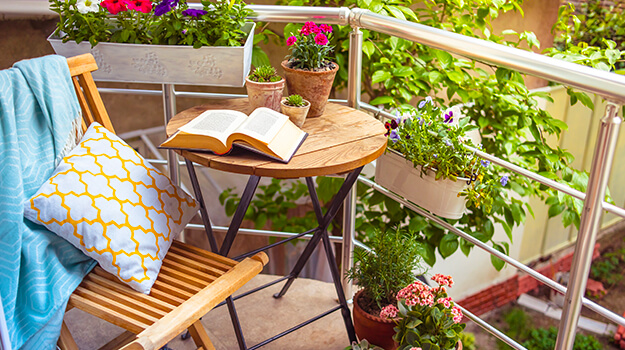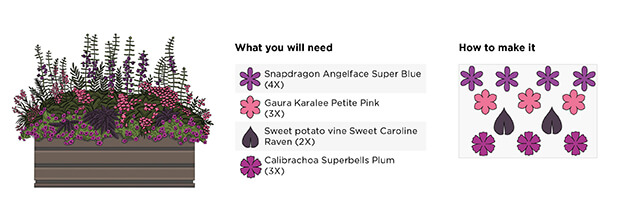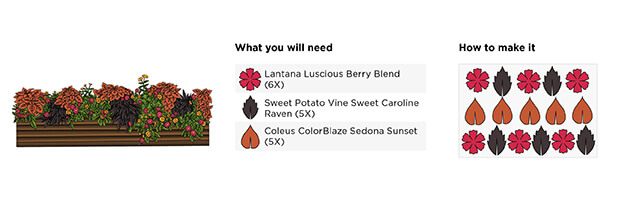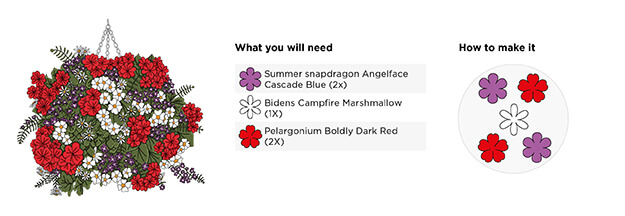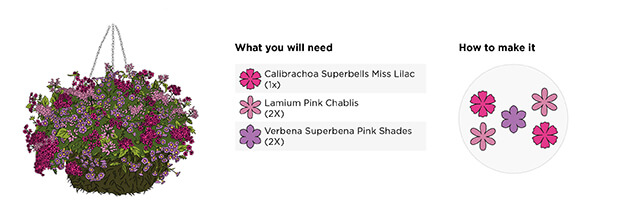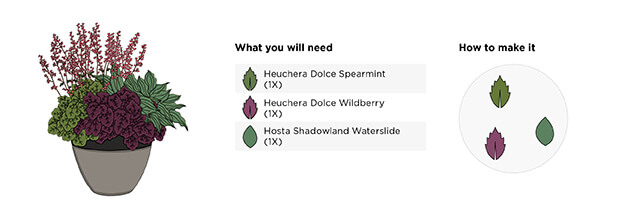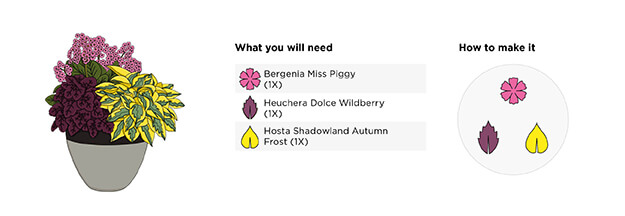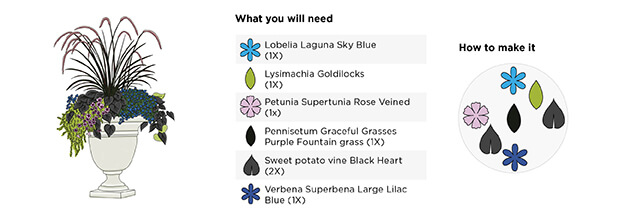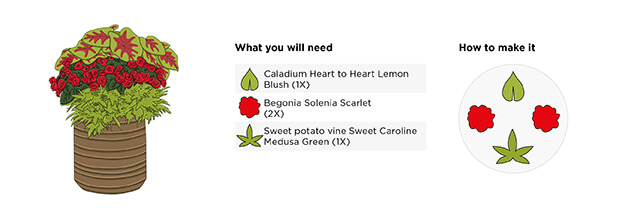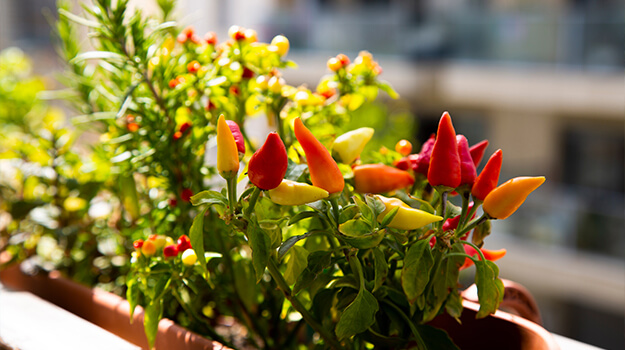- How many plants in my pot?
- What type of plants for my pots
- Making an outdoor centrepiece
- How to make a balcony box
- Which plants for a hanging planter
- Dealing with perennials
- What to do in winter with your pots
- Grasses in your potted arrangements
- Create potted arrangements with your houseplants
- How to make a potted arrangement with edible plants
To create spectacular arrangements, you just need to follow a few simple rules. When you make your purchases, you should consider the ideal number of plants for the size of the pot and you need to arrange them to highlight their features. Take inspiration from the diagrams and illustrations in this article to create your own masterpieces!
How many plants in my pot?
Are you decorating for an event taking place in early summer? Choose larger plants or plant them in larger numbers. The effect will be almost immediate! Nevertheless, you will probably need to rework your pots once your plants have grown.
A pot containing too many plants will give a nice effect immediately, but it will be short-lived. Once the plants reach maturity, they will not have the space available to flourish and offer abundant flowering. On the other hand, a pot that does not contain enough plants can disappoint throughout the season.
Not in a hurry or limited by your time or budget? Plant smaller, according to the quantity recommended below. Despite a timid start, it won't take long for your flower boxes to steal the show in the garden!
Although this may vary depending on the plants chosen, the following quantities can give you an idea of how many plants you will need when planting in a round container:
- 10" to 12" pot: 3-4 plants
- 14" to 16" pot: 5-7 plants
- 16" to 20" pot: 6-9 plants
When it comes to a rectangular balcony planter, take into consideration its length and width. You’ll find different examples for arranging your plants in the last part of this article.
To find out which potting soil to use and how to maintain your pots during the summer, read our article: How to have beautiful planters all season long
What type of plants for my pots
In the classic balanced composition, there are three types of plants, each of which has a role to play.
1. The focus or upright plant
It is a tall plant that grabs attention and catches the eye. It will find its place in the centre of your pot unless the latter is placed against a wall (in which case you will place it at the back of the pot). The centrepiece should be spectacular, not only in its height, but also in its colour, shape or size. It is often a large-scale plant.
Some suggestions: canna, banana tree, fountain grass, alocasia or colocasia (elephant's ear), dracaena (spikes), lobelia, bird of paradise, cleome.
2. Filler plants
Thanks to their bushy habit, these plants surround the focus plant, allowing you to quickly fill the pot to give it that much sought-after fullness. (If your pot is placed against a wall, place them in front of the main plant.)
Look for generous plants, which produce in abundance, whether foliage or flowers.
Chosen for their colours, shapes or textures, these plants provide arrangements with careful harmonies or striking contrasts.
Some suggestions: verbena, geraniums, lantana, petunias, coleus, calibrachoas (Million Bells), begonias, marigolds, impatiens, hostas, coral bells, alyssum.
3. Hanging plants
Placed on the edge of the container, they hide the edges and cascade all around, extending the colour and the effect of abundance. Look for plants with long stems or hanging foliage.
Perfect for adding movement and lightness to overly rigid compositions, they soften angles and are essential for giving elegance and refinement to pots and hanging baskets.
Some suggestions: calibrachoas (Million Bells), creeping sedum, ivy geranium, scaevola, ivy, lysimachia (yellow loosestrife), sweet potato vine, browallia.
Making an outdoor centrepiece
It is possible to create a pretty potted arrangement to decorate the table on the deck or patio. Longer lasting than a cut flower bouquet, but just as colourful, your centrepiece does not have to be limited to a single variety of plants. In a smaller pot, however, you can limit yourself to 3 plants which you will arrange to form a triangle.
As there will be fewer plants, go for long-lasting flowers and, in order to always be ready for an impromptu dinner on the patio, choose plants whose flowering is not conditional on having to remove the faded flowers. In this regard, modern hybrids rank right at the top.À
Our suggestions: hybrid alyssums L. x Snow Princess, Blushing Princess or those in the Knight series, the new petunias and supertunias, begonias, impatiens, African daisy: Soprano or Symphony (the new flower buds cover the old fading flowers), ivy geranium.
How to arrange a balcony box
Balcony boxes are usually not as deep and are placed higher up, so the plants will have to be less ambitious. Centrepiece plants should be of medium size, otherwise they will hide the view and distort the arrangement. It will also be easier to make your balcony boxes successful by combining only filling plants and hanging plants.
Be careful which containers you choose. Narrow, shallow containers dry out very quickly and your plants will suffer. If you don't want to water twice a day, go for a depth of 30 cm or more, which will save some watering!
Which plants for a hanging planter
Hanging baskets are more often seen in a round container with a quantity of filling plants. Tall plants don't really suit them, so hanging plants will be spectacular, flowing in abundance or disproportionate length.
For a beautiful basket, bushy, compact and moderately upright filling plants are placed in the centre of the pot to give volume to the composition. You then place the hanging plants at the edge.
Perched up high, hanging baskets can be subject to bad weather. Choose strong plants whose stems won’t break at the first gust of wind. Place your pots far enough away from walls and other obstacles that they could hit in high winds.
Finally, make sure that your baskets are securely anchored. Once well watered, the pots can be heavy. For this same reason, try to limit yourselves to containers with a diameter of 30 to 40 cm (12 to 16 in).
Dealing with perennials
Perennials make it possible to create splendid floral arrangements. Their flowering period, often shorter than that of annuals, can be compensated with colourful and nicely cut foliage. Among the plants to favour, hostas and coral bells stand out. These plants can belong alongside other perennials as well as with annuals, tropical plants or grasses.
Why use perennials in your planters:
- You can get large plants at the garden centre, but also from your own flower beds. There is, for that reason, no need to wait until summer before having well-stocked planters.
- Perennials can be reused year after year and save money. Simply put them in the ground in the fall (with or without their pot!) to prevent their roots from freezing. Unlike annuals, they will survive the winter and can be used to make new flower pots the following spring.
- They provide access to a palette of colours, shapes and textures, reusable at will, right from the garden. In the spring, combine a variegated hosta and white astilbes with red begonias to create a vibrant pot. In the fall, replace them with a yellow hosta, a purple coral bells and a golden grass for a creation in the colours of the season!
Here are some perennials that will look spectacular in your pots:
- Hostas for their beautiful variegated leaves, lime green, yellow, green-grey in colour…
- Coral bells for their delicate flowering and their pink, purple, coral, orange or violet foliage…
- Sages for their great variety: Russian sage, tri-coloured sage, golden sage
- Lavender for its great tolerance to drought and the sweet scent of its flower spikes
For their flowers or their distinctive habit: bellflower, lysimachia (yellow loosestrife), periwinkle, stonecrop, heather, yarrow, aster, perennial geranium.
What to do in winter with your pots
Plants grown in pots are less hardy than those grown in the ground. In northern areas, the roots of perennial plants which survive the winter without problem are more likely to freeze when exposed to the elements and confined in a pot.
To find out if you can simply store the pot in a more sheltered place during the winter, subtract at least two hardiness zones from your plant. So, a hardy perennial in zone 5 should be considered a zone 7 plant - and perhaps more - when grown in a container.
To guarantee they survive until spring, you must bury them in a flower bed, with or without their pot. You will do the same with shrubs and trees grown in pots.
Note that perennial plants aren’t the only ones that can be used the following year. Some annuals can be saved by bringing them inside for the winter, as is or in the form of cuttings. They will not be at their best in the house, but they will survive to regain all their vigour when the warm season returns.
Bulbs and tubers can also be dug up and stored indoors during the cold season. They will go dormant until spring. A nice exception to the rule, cannas can remain in their pot to compete in beauty with your houseplants. Once settled in comfortably in your house, some will even go so far as to show their appreciation with a magnificent flowering.
To find out more, read: Summer bulbs: how to grow them indoors
Grasses in your potted arrangements
With their spectacular display, grasses can be a sensation in all arrangements. As they tolerate heat well and do not require excessive watering, you should reserve a special place for them in your pots.
Their graceful habit and upright shape make them perfect centrepiece plants. Matching all colours, they find their place in all arrangements.
You should choose fast-growing annual varieties, or perennial varieties that will grow year after year. This is also the opportunity to obtain these beautiful aggressors, so feared because of their tendency to spread and become uncontrollable in the garden. Once confined in a pot, all grasses are well behaved!
Have you decided to go with a perennial grass? In northern regions, as winter approaches, you’ll need to bury your pot with the plant in it! Every two years, remove the root ball from the container, divide it and replant the divided plant with fresh potting mix.
PRO TIP: Be careful of any varieties that become gigantic... They will make short work of their neighbours. In a pot, space is limited, as are water and nutrient reserves. Each plant must have enough space, otherwise the competition will be fierce.
Our favourites for your potted arrangements:
- Leymus arenarius (lyme grass)
Dazzling and invasive in the garden, in a pot, it’s wise and charming! Its foliage and blue-grey flower spikes bring an original touch to the pot. - Helictotrichon sempervirens (blue oat grass)
At its best in the sun, it requires little maintenance. - Pennisetum setaceum Rubrum (purple fountain grass)
Its burgundy red foliage and purple flower spikes set the tone for the composition. - Hakonechloa macra Aureola (hakone grass)
A grass for shade. Its golden-striped leaves take on a dazzling copper hue in fall. Just add autumn chrysanthemums for a conversion to the rhythm of nature. - Pennisetum First Knight (First Knight fountain grass)
New! The darkest pennisetum whose colouring becomes increasingly dark under the effect of hot temperatures. You’ll love its arching foliage and its upright stems that can reach 1.5 metres high. - Carex siderosticha Banana Boat (creeping broad-leaf sedge)
Its banana yellow foliage edged with green illuminates the dark corners of the garden. Spectacular effect guaranteed!
Create potted arrangements with your houseplants
Most houseplants love spending the summer outdoors. While repotting them, why not integrate them into your arrangements? An alocasia or bird of paradise plant can easily be used as a centrepiece in a floral arrangement that includes perennials or annuals.
For inspiration, choose from the following suggestions:
Focus plant: sansevieria (snake plant), alocasia, colocasia (elephant’s ear), yucca, banana tree, strelitzia (bird of paradise).
Filler plants: caladium (heart of Jesus), strobilanthe (Persian shield), ferns, purple oxalis, wandering Jew.
Hanging plants: goldchild ivy, hedera climbing ivy, Isabelle peperomia, pilea glaucophylla (Silver Sparkle).
How to make a potted arrangement with edible plants
Many edible plants are grown in containers. Some, like mint, are easier to control there. Others, like lemon basil, lemongrass or peppermint, will help repel mosquitoes. Even more reason to keep them on the balcony!
Take care to arrange edible plants according to their needs (water, soil type and exposure). For the best harvest and minimal maintenance, practice companion planting. Download our practical guide to find out the winning associations: Companion planting guide
Finally, let aromatic herbs bloom or add edible flowers to invite pollinators and add colour (marigold, nasturtium, pansy).
For inspiration, choose from the following suggestions:
- Focus plant: cherry tomatoes, peppers, hot peppers, eggplant, cloves, lavender, lemongrass, dill, rosemary.
- Filler plants: bush tomatoes (Maja, Red Robin, Bianca Cherry, Dona, Orange Berry, Yellow Submarine, Sweet Cassidy), Vietnamese cilantro, chives, purple basil, Italian parsley, marigolds, curly parsley, Swiss chard, colourful lettuces, kale.
- Hanging plants: mojito mint, strawberries, cucumbers, nasturtiums, wild thyme.
To find out everything about growing edible plants in containers, read our article: The Best Vegetables to Grow in Containers
To find out how to maintain your containers so that they stay beautiful all summer, read our article: How to have beautiful planters all season long

